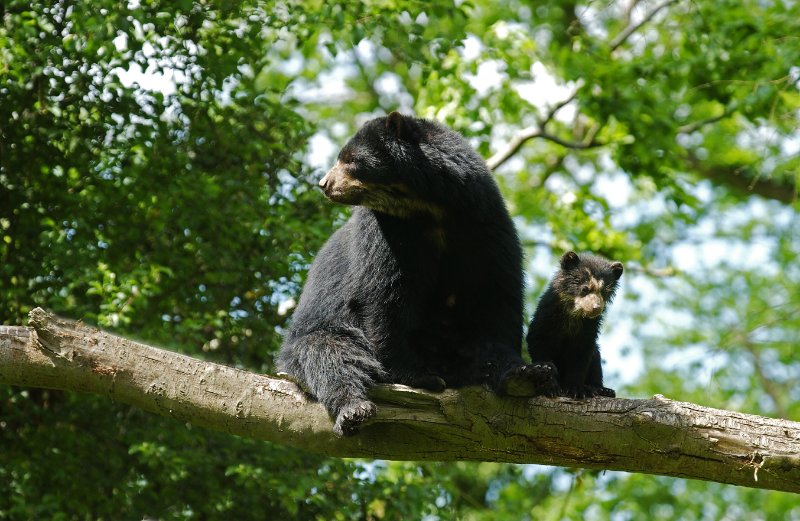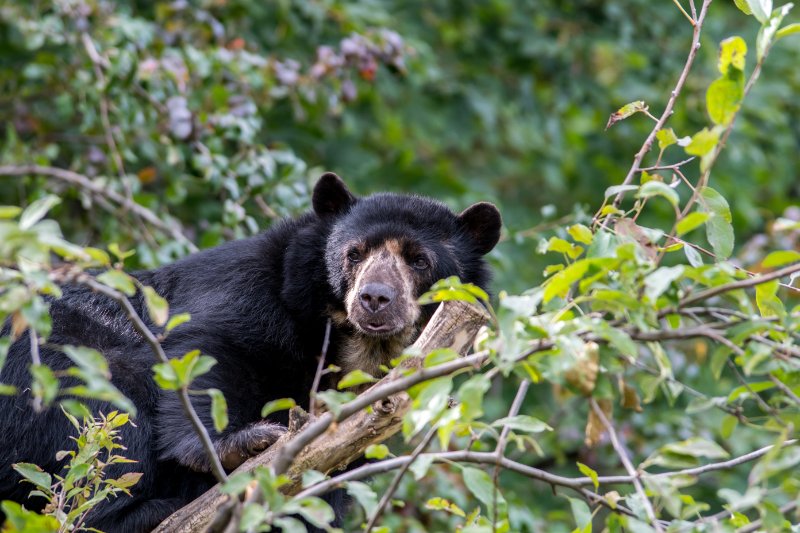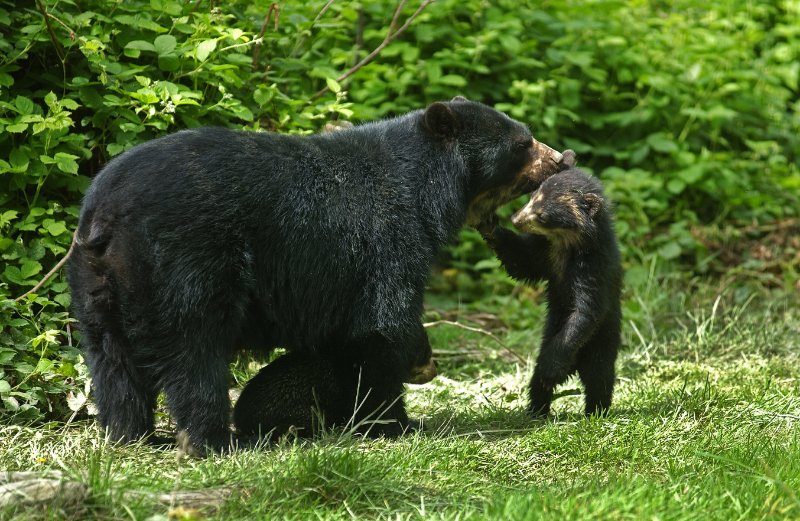Spectacled Bears are the only bears in the world that live in the tropics. They are found in South America, from Colombia to northern Argentina. Spectacled Bears have short, reddish-brown fur and black markings around their eyes that give them their name.
- Status: Vulnerable
- Known as: Spectacled Bear, Andean bear
- Estimated numbers in wild: Less than 3,000
These bears are considered “vulnerable” by the IUCN because their populations have declined by more than 30% over the past three generations.
The main threats to Spectacled Bears are hunting and habitat loss. These Andean Bears are also killed when they wander into villages or fields looking for food.
Description of Spectacled Bear

Spectacled bears live in the rain forests of Ecuadorian Andes Mountains. They spend most of their time foraging for food or sleeping high up in trees to avoid predators such as jaguars and mountain lions.
Spectacled bears have a short tail with a white tip, black rings around their eyes, and dark brown fur on their head. Spectacled bears are about the same size as an American black bear.
The spectacled bear is the only bear species living in South America, and could probably be described as a medium-sized bear. A spectacled bear boar can weigh up to 200 kilograms, while a large female might weigh only about 85 kilograms.
Anatomy and Appearance

Spectacled bears can be from 120 centimeters to 200 centimeters in length. The coat of a spectacled bear is usually black, but color variations can include brown or rust.
They range from brown to blonde in color, and can weigh from 54 to 200 kg (120 to 440 lb). They live in forests and wooded areas at elevations of up to 4,500 m (14,800 ft).
The bear is named for the white or pale yellow markings on the face, which encircle the eyes on some of the bears, giving the impression that they are wearing eyeglasses.
The spectacled bear has a short snout in comparison with other bear species, and a much rounder face.
Spectacled Bear Color and Eye Markings

Spectacled bears have distinctive coloration, with brown fur that has black markings around the eyes, which give the species its common name.
These markings are thought to help them camouflage themselves in the mountainous forests of South America where they live. They also have white fur on their chests and bellies.
Despite their coloring, these creatures are easy to spot due to their large size. Adult males typically weigh between 150 and 300 pounds, while females weigh between 100 and 200 pounds. Spectacled bears are the largest members of the bear family found in the Americas.
Spectacled bears can be distinguished from other bear species by their eye markings, which consist of a black band around the eyes against a lighter brown or beige background.
They are the only bear species that have this distinct coloration. Andean bears also have small, round ears and long claws on their front feet which they use for digging, climbing trees, and fighting.
Location
Spectacled bears are found in the rainforests of the Andes Mountains in western South America. They can be found in Venezuela, Columbia, Peru, Bolivia, Chile, to Argentina.
Spectacled Bear Habitat

As with Asian bear species, they are comfortable climbing trees and also building platforms in them.
Spectacled or the Andean bears prefer living in the cloud forests of the Andean region. They will climb trees to avoid humans. Mother bears defending cubs have attacked humans, but no human deaths have been laid at the spectacled bear’s door.
While spectacled species of bear are mostly solitary, they do sometimes form small groups when foraging. The bears will form pairs during the spring and the young are born in the Southern Hemisphere summer of November through February.
The cubs are naked, blind, and helpless when born and are dependent upon the sow for up to 8 months afterward. The number of cubs born (1 to 3) is linked directly to the size and health of the sow.
See Related: What Attracts Bears?
Spectacled Bear Diet and Nutrition
Like most bears, they eat almost anything, although their diet is heavily weighted towards vegetative matter – only about 5% of their food is actually meat.
Spectacled bears appear to favor bromeliad fruits in particular, although they also eat cacti, palm nuts, and carrion.
These bears remove the outer bark from trees to feast on the cambium layer beneath.
The strong jaws and teeth, and highly developed gastrointestinal system of the spectacled bear allow it to access many food sources that would be indigestible to other animals.
See Related: What Happens to Excess Carbohydrates in Animals?
Spectacled Bear Mating Habits

Spectacled bears mate during the months of January to March. These creatures are solitary animals and only come together for mating.
They are not territorial animals, but the male Spectacled bear will fight other males for the chance to mate with a female.
These bears have a gestation period of around 190 days, after which they give birth to 2 or 3 cubs. Spectacled bear cubs stay with their mother for 18 months to 2 years.
Females give birth to one baby each year after a gestation period of about five months. Spectacled bears live for approximately 20 years in the wild. They are considered to be threatened species.
See Related: Grizzly Bear vs Black Bear: What’s the Difference?
Spectacled Bear vs Other Bear Species
The Spectacled Bear is different from other Bear species because it is the only species of bear that has markings around its eyes that look like glasses or spectacles. These markings give the bear its name.
The Spectacled Bear is very similar to other bear species in terms of its physical features, diet, and behavior. They have a black body with a white muzzle and chest. They are the only bears that have these markings, which gives them their name.
These bears are omnivores and eat mostly fruits, insects, honey, and small mammals. They are also known to scavenge for food. Spectacled live in forests and are very good climbers. They are typically shy but can be aggressive when threatened.
The main difference between Andean Bears and other bear species is their habitat. Spectacled live in the tropics, while other bear species live in colder climates. They are also the only bear species found in South America.
Spectacled Bears have adapted to living near humans and often live in old-growth or second-growth forests, swamps, and pine plantations. Spectacled Bears typically avoid open habitats such as grasslands and agricultural areas where food is scarce.
Spectacled Bear as a Predator

Spectacled bears are predators, and they mainly eat fruits, leaves, and insects. However, they have also been known to eat small animals, such as rodents or porcupines.
Spectacled Bear as a Prey
Spectacled bears are prey for many different predators in the wild. Jaguars, pumas, and wolves are all known to hunt and kill spectacled bears. They are also prey for birds of prey such as harpy eagles and Andean condors.
These animals rely on their sharp senses to detect the movement of their prey from a distance and then swoop down to take it down.
Spectacled bears have several adaptations that help them protect themselves from predators. One is their coloring; they are mostly black, which helps them blend in with the surrounding forest.
They also have long claws and sharp teeth, which can be used to defend themselves or catch prey. These creatures are also good climbers, which allows them to escape danger by climbing up trees.
Role in the Ecosystems
Spectacled bears are important in the ecosystems they live in because they help to disperse the seeds of the plants they eat.
These creatures also play an important role in maintaining the balance of the forest’s ecosystem by eating plant species that are overpopulated.
The Spectacled Bear is an endangered animal and if it becomes extinct, the ecosystems will be impacted.
These bears are key species in the Andean forests and their extinction would have severe consequences for the entire ecosystem. The disappearance of Spectacled species of bears would also lead to a decline in the populations of other animals in the region, including jaguars, deer, and tapirs.
See Related: Animals That Start with the Letter X
Behavior

They are shy animals and typically avoid humans. However, they can become aggressive if they feel threatened. Spectacled bears can reach speeds of up to 35 mph (56 km/h) when running.
Spectacled Bear Facts
Here are the interesting facts about Spectacled Bears that you need to know.
- Spectacled Bears are one of the most adorable animals in the world.
- They’re also one of the most endangered.
- These creatures are found in the Andes Mountains in South America.
- These bears get their name from the markings around their eyes, which look like glasses.
- They are threatened by habitat loss and hunting.
- These bears are the only bears in the world that have spectacles-like markings around their eyes.
Conservation Status
The conservation status of the Spectacled Bear is important because they are a vulnerable species.

Threats
As with many species of animals, habitat destruction is contributing to the loss of spectacled bears.
The encroachment of agriculture, logging, and mining not only destroys forestland but also fragments the bears’ range, making inbreeding more likely.
Farmers often shoot the bears thinking that they will attack domestic animals, and spectacled bears are also poached for their gallbladders, used in Oriental ‘medicines’.
These creatures are listed as Vulnerable on the IUCN Red List, which means they are at risk of becoming endangered if conservation efforts are not increased. They are listed as Vulnerable because of hunting and habitat loss.
One reason that Spectacled Bears are in danger is that these species live in very small areas. Spectacled Bear habitats only take up about 7 percent of their original range. Spectacled Bears used to be spread all over the Andes, but now these bears are found in much smaller pockets throughout their former habitat.
Another reason why Spectacled Bears are threatened is that Spectacled Bears are hunted for their meat and pelts. Spectacled bear flesh is often sold as land animal meat, but Spectacled Bear meat is also used to make sausages.
Spectacled bears were also affected by hunters who killed Spectacled Bears in order to capture Spectacled Bear cubs to sell them to the pet trade.
Spectacled Bears are also threatened by habitat loss because Spectacled Bears rely on isolated pockets of forest for survival. Spectacled Bear populations have been decreasing since the 1900s due to their habitat being destroyed.
There is not much known about these Bears, but there has been recent research that has shed some light on Spectacled Bears.
These creatures became the first wild species to have their complete genome sequenced. Spectacled Bear genomes were compared with those of Giant pandas and Polar bears in order to better understand the Spectacled Bear as a bear species and how they adapted to life at high altitudes.
See Related: Facts About Conservation
Conservation efforts

Although the spectacled bear is nominally protected throughout most of its range, the lack of personnel in parks and reserves mean that the bear is generally left without any meaningful protection.
NGOs have been important in working with South American governments to help provide a meaningful way to protect the bears while still supporting local human populations.
Captive breeding programs are also in place to help assure that this species survives.
Here are some of the Conservation efforts that help to protect Spectacled Bears
- Spread awareness about Spectacled Bear and the threats they face
- Advocate for Spectacled Bear conservation
- Fundraise for Spectacled Bear conservation
- Connect with local conservationists working to save Spectacled Bear
- Purchase goods that support Spectacled Bear conservation
See Related: Best Conservation Posters
Organizations
Bear Trust International

Bear Trust International is an American organization that works to protect different bear species around the world and their habitats through education, research, management, and habitat conservation.
Bear Trust International is a nonprofit organization that is dedicated to the conservation of bears around the world. They work to protect the bears and other bear species from extinction and also work to educate people about the importance of these animals. Bear Trust International relies on donations from people who care about conservation to support their important work.
Hauser Bears

The Hauser Bears. These species of bear are listed as vulnerable on the IUCN Red List, with a decreasing population trend. There are many threats to Spectacled Bears, including habitat loss and fragmentation, hunting, and climate change.
Hauser Bears is a UK-based charity with a mission to change people’s attitudes towards bears. Their main work revolves around research and education to ensure a future for all bear species.
Check out this list of other top environmental organizations in Europe.
North American Bear Center

The North American Bear Center is a nonprofit organization that is dedicated to the conservation of black bears and grizzly bears. The center is located in Ely, Minnesota, and it was founded in 1992.
The main goal of the center is to promote public awareness about the ecology and behavior of bears. The center also strives to provide research and education about bear conservation.
The North American Bear Center is a conservation and education facility dedicated to the preservation of black bears and grizzly bears. The center features interactive exhibits, films, and live animals. The center’s conservation efforts include research, education, and rehabilitation.
See Related: Fastest Animals in the World
World Wide Fund

The Spectacled Bear is a vulnerable species that is native to Andean forests in South America. Spectacled bears are the only bear species in the region and are named for the markings around their eyes, which resemble eyeglasses.
These animals have long been hunted for their fur and other body parts, which has contributed to their decline. In addition, these species are threatened by habitat loss and fragmentation due to deforestation and development.
The World Wide Fund is working to conserve Spectacled Bears and their habitats.
WWF helps protect Spectacled Bears through community outreach and education programs, as well as by working with governments and businesses to promote sustainable development practices.
WWF also funds research on Spectacled Bears and their ecosystems to better understand how to protect these bears.
See Related: Best Wildlife Conservation Jobs
Conclusion

Spectacled Bears are a vulnerable species that is native to Andean forests in South America.
Spectacled bears are the only bear species in the region and they have long been hunted for their fur and other body parts, which has contributed to their decline. In addition, they are threatened by habitat loss and fragmentation due to deforestation and development.
The World Wide Fund and Bear Trust International are working hard to conserve the bears through community outreach programs as well as sustainable practices with governments and businesses.
The North American Bear Center strives for public awareness about the ecology of bears while promoting research on these animals; meanwhile, Hauser Bears focuses more specifically on education for people’s attitudes towards different bear types around Europe.
FAQ
What is Spectacled Bear?
Spectacled Bears are the only bears in the world that have blue eyes. Spectacled Bears (Tremarctos ornatus) are a species of bear that is endemic to South America.
They are the only living species in the Tremarctos genus and are most closely related to the American black bear (Ursus americanus). These bears’ ears can be distinguished from other bears by their characteristic markings around their eyes, which give them their name.
What is the Spectacled Bear population trend?
The Spectacled Bear population trend is decreasing. There are less than 20,000 Spectacled Bears left in the wild, and their population is declining by 2-3% each year. Hunting and habitat loss are the main threats to these species
What are threats to Spectacled Bears?
Spectacled bear populations are threatened by habitat fragmentation through deforestation, urbanization, and agricultural plantation.
This is exacerbated by poaching due to the bears’ use in traditional medicines and crafts, the pet trade, and live trapping for private zoos.
They were also heavily exploited during the 1990’s Colombian civil war when military troops spared them little attention because they were not targeted as food or trophies.
Is the spectacled bear aggressive?
Spectacled bears are solitary animals and they’re not aggressive. Spectacled bear cubs will prematurely leave the den before their mother leaves if they have to walk past a dominant adult spectacled bear.
These creatures suffer from the same ills as humans, with alcohol consumption being one of them, if only in captivity.
Why Spectacled Bears are important?
Spectacled Bears play an important role in the ecosystems in which they live. They help to disperse the seeds of many different kinds of plants, and they also prey on animals that can damage forests and other habitats.
They are one of the most important seed dispersers in their ranges, and their loss could have serious consequences for the health of these ecosystems.
Other Species Profiles
Related Resources
